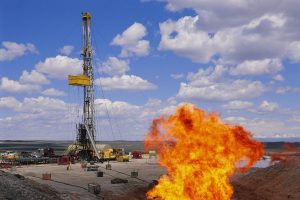 Last month, President Biden signed into law S.J. Res. 14, a Congressional Review Act resolution restoring methane pollution standards for the oil and gas sector by repealing Trump-era rollbacks. With bipartisan backing, Congress passed the measure and rejected the Trump administration’s dangerous weakening of methane protections and its unlawful attempt to prevent the Environmental Protection Agency from setting stronger standards in the future.
Last month, President Biden signed into law S.J. Res. 14, a Congressional Review Act resolution restoring methane pollution standards for the oil and gas sector by repealing Trump-era rollbacks. With bipartisan backing, Congress passed the measure and rejected the Trump administration’s dangerous weakening of methane protections and its unlawful attempt to prevent the Environmental Protection Agency from setting stronger standards in the future.
With these protections restored, this fall EPA will propose additional standards for both new and existing sources of methane emissions.
Immediately re-enacting protections at new wells and compressor stations
Upon signing of the CRA resolution, the 2016 methane standards went back into effect as if the Trump rollback never occurred. The standards apply to oil and gas wells, processing plants and other facilities across the country that were built or modified after 2015.
With oil and gas pollution rules restored, what’s next for EPA on methane? Share on XEPA recently released guidance to aid oil and gas operators in ensuring that they are complying with these safeguards. Those subject to the standards must take steps to curb emissions, including conducting monitoring and repair of equipment leaks at all new wells (including low-production sites) and compressor stations. These requirements underscore the importance and feasibility of reducing emission sources across the industry.
By soundly rejecting the rollback, Congress cleared the way for EPA to propose and adopt protective new standards without having to untangle the last administration’s deeply flawed legal interpretations. Passage of the CRA resolution and the accompanying House Energy and Commerce Committee Report reaffirms EPA’s longstanding authority and obligation to reduce methane from both new and existing sources in the oil and gas sector.
“…upon reinstatement of the 2016 Oil and Gas Rule, the Committee strongly encourages the EPA to take swift action to reverse the damage caused by the 2020 Rescission Rule, strengthen its regulations for new sources, and fulfill its statutory obligation to issue existing source guidelines under section 111(d)” -House Energy & Commerce Committee Report
Strengthening rules to protect communities, tackle climate change
In his day-one executive order, President Biden directed EPA to propose new methane rules for older, unregulated oil and gas facilities by this fall. EPA has been working toward this deadline, even as Congress debated the resolution to restore the 2016 methane rules.
Recently, EPA hosted public listening sessions to gather input on oil and gas standards where EDF experts — alongside hundreds of other impacted residents, environmental justice advocates and companies — testified in favor of strong new standards based on the best available and most recent scientific and technological developments.
To achieve methane reductions consistent with the Biden administration’s climate goals and efforts to limit global temperature rise to 1.5°C, EPA’s next generation standards must be protective and innovative.
New peer-reviewed science underscores the crucial role methane reductions must play in heading off global temperature increase, and the oil and gas sector — responsible for 35% of human-caused methane emissions — is also the sector with the greatest reduction potential. In addition, oil and gas production is a major contributor to smog and hazardous air pollution that seriously burdens the health of nearby communities. Robust rules to curb emissions from oil and gas sources are both a climate imperative and necessary to protect the health and well-being of frontline communities.
EPA standards that require frequent monitoring and repair of leaks, reduce or eliminate the wasteful practice of flaring, ensure the use of low- and zero-emitting technologies, and apply broadly to all sources of harmful pollution, can reduce the sector’s methane emissions by 45-65% by 2025. Many of these solutions are low-cost to operators who may even profit by selling the captured gas.
EPA is continuing to gather information as it develops next generation standards for oil and gas sources, holding a workshop on methane detection technologies later this month. By September, the agency will formally propose regulations for both new and existing sources. After taking public comment, EPA has announced it will revise and finalize the regulations by October of 2022.
For new sources, the revised rules will take effect shortly after finalization. For existing sources, EPA must publish guidelines that help to enable states to develop compliance plans for these older sources. Once states submit their plans for existing sources, EPA will approve plans that meet all of the Clean Air Act requirements. If a state chooses not to submit a plan (or if its submitted plan does not meet all of these requirements) EPA will move forward with federal standards that ensure clean air protections are in place.
As major oil and gas producing states such as Colorado, New Mexico and Pennsylvania have shown, strong emission protections can be implemented in a way that safeguards our economy, climate and the health of our communities. Collectively, these states’ actions raise the bar for federal methane leadership and point to the need for protective rules from the Biden administration and EPA to safeguard communities and help to address the climate crisis.
EDF Legal Fellow Edwin LaMair contributed to this post.









